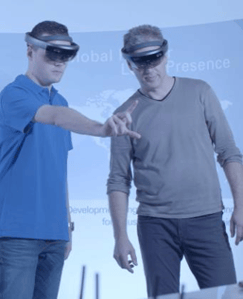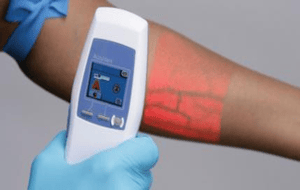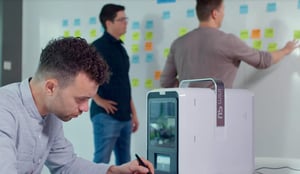Virtual team meetings and conferences, even online happy hours, have replaced in-person business activities, and many experts say this will be the norm for years to come. As COVID-19 spread and the world went home to work, the development of virtual, augmented, and mixed reality technologies have suddenly become less science fiction and more practical necessity.
The proliferation of innovation and digital expansion may be the most important silver lining behind the coronavirus pandemic. IDTechEx has predicted the “extended reality” (XR) market will surpass $30 Billion in the next ten years.
This is not a new technology, says Christian Suurmeijer, one of Benchmark's senior design engineers in The Netherlands. But, he notes, there’s an urgency today to further develop smarter, faster, and more convenient ways for people to connect and work effectively through XR.
To learn more about this expanding industry and Benchmark’s place in it, I recently chatted with Christian, as he sat in a train station, sharing his screen (and the passing train sounds) from 5,000 miles away.
First, Let’s start with some definitions.
Sure. So, there’s “Extended Reality” (XR) or augmented technology, which includes virtual, augmented, and mixed realities.
“Virtual reality or “VR” is when the user is shut off from the outside world but can see inside a different world through a lens or goggles. VR devices like Playstation VR, Oculus Rift or Quest have been on the market for  nearly a decade. The goggles create an immersive, 3D sensation that works well for commercial research, development, gaming, and other consumer-facing activities. VR is the most popular technology right now, and I’d say 50% of engineers and people in the product design industry are using this technology in one way or another.
nearly a decade. The goggles create an immersive, 3D sensation that works well for commercial research, development, gaming, and other consumer-facing activities. VR is the most popular technology right now, and I’d say 50% of engineers and people in the product design industry are using this technology in one way or another.
Then there’s augmented reality, or “AR,” which produces a digital overlay on top of the physical environment or a handheld screen. This technology gives the user the sensation of looking inside something—a body or a building—to gather information that can’t otherwise be seen. AR is still a smaller percentage of the market because of its complexity. In most applications, AR still requires a robust infrastructure that must pull data from multiple sources. Depending on the desired product or outcome, the process can take a lot of time and effort.
For many of our design and development purposes, the Benchmark engineering team uses Microsoft’s HoloLens—which is considered a mix of AR and VR, or mixed reality (“MR”). With multiple sensors, advanced optics, and holographic processors, the HoloLens can display information, blend with the real world, and even simulate a virtual/holographic world.
Most of the opportunities for AR are in complex industrial and medical applications. This is where Benchmark is building expertise and working on interesting new innovative applications.
MR technology is still relatively expensive, so it’s only used in applications where the added value is suitable for implementation. Not only do you need the hardware, but you also need to build apps and set up the supporting infrastructure. Although mixed reality technology is very advanced, it is not yet compact and light enough to serve all applications.
Besides the advanced MR technology like the HoloLens, more basic applications also use augmented reality, such as thermal imaging. It adds an information layer to reality and lets us see things we can’t see with our naked eyes.
What are some examples of XR products in the market?
Benchmark has engineered and manufactured two well-received AR products that have been in-market for a while.
The AccuVein vein finder is a device for medical imaging and guidance. It enables medical professionals to “see” a patient’s veins for more accurate treatment. It’s a bit like Superman’s X-ray vision, seeing veins under the skin. But in this case, it’s detecting and projecting sensor data on the top of the skin via an invisible infrared laser and a visible red laser.
That’s what AR is all about—enabling users to visualize data in realistic, non-invasive ways.
Another industrial use-case is the handheld Fluke ii900 Industrial Sonic Imager that functions as a leak detector. It enables a user to “see” what an array of highly sophisticated microphones “hear” to help engineers locate air, gas, and vacuum leaks even in noisy industrial environments. A screen on the device pinpoints the leak by recognizing a specific sound frequency to aid in repairs and ensure energy efficiency, safety, and cost management.
Beyond medical and industrial applications, what other opportunities do you envision for XR technology?
Education and training, hands-free servicing and guidance applications, and even collaborative robots or “cobots” are emerging trends right now. For instance, with XR, you can train employees in another part of the world, in real-time, on realistic problems where everyone can see, “touch,” and learn virtually.
As I mentioned previously, engineering and design projects benefit from AR and VR, too. These technologies enable 360° design reviews, the ability to create a virtual showroom for product demos, and even more realistic video conferencing.
Do You think there’s more innovation to come?
So much more. I’m not sure we can envision all the possibilities—from highly complex to everyday uses. Our Almelo team is part of the Industrial Reality Hub, a field lab consortium, where companies experiment with these new technologies. It’s a very active group—where there’s always a lot happening.
Each member company has a specialty. Some of the members focus on training; others are experimenting with virtual guidance for production or warehouse operations. When a customer talks to Benchmark about a VR or AR concept and a challenge that needs an XR expert, we know where to go.
How do XR projects evolve at Benchmark?
We don’t just automatically say, “let’s use extended reality” for every project that comes in. It’s a much more organic process.
A customer will come to us with a specific problem, specification, or product concept. Then we start thinking about how to help—and what kind of technology is best for that product and the market. Collaborating closely with our customers, we may develop the idea in one of our Creative Workshops. Other times, our engineers  know that integrating new technology is the logical next step for an existing product.
know that integrating new technology is the logical next step for an existing product.
XR may not be right for every application. The investment in product development needs to align with market value. The most significant investments in augmented technology have to do with the information infrastructure that needs to be built up or adapted for augmented reality. So, it’s essential to consider whether doing so adds value. We partner with our customers to help make these types of decisions.
It’s a good sign that more of our customers see XR as a valuable technology to improve their products, which provides even more value to their customers in terms of efficiency and speed.
Does every AR project require so much foundational work?
Sometimes, when the data is not readily available. AccuVein, for instance, is a dedicated application. So, the data infrastructure is far less complicated than one in which you need to gather data from a physical location, systems engineering, mechanical, electrical, etc.
If everyone sees value in the result, it might be worth it, but we want to make sure customers understand what is, or is not, cost-effective.
What other XR projects are your team working on right now?
We’re always trying to refine this technology to help people do their jobs more efficiently. Right now, we’re working on integrating AR technology into a traditional safety helmet for industrial use. We know that wearing hardhats or helmets is not unusual for this market, so it’s an excellent place to introduce this concept.
The AR helmet concept consists of the hardhat, holding sensors and front-end measurement hardware, a power supply, and Benchmark’s IoT Smart Gateway platform, an essential building block for our XR development. Considered our control platform, it’s secure, cost-effective, and proven—enabling lower development costs and faster speed-to-market.
What’s your vision for the future of XR technology?
I see XR as an efficient tool to make life easier by showing and sharing information and data all around us. It makes the data and information we see on our smartphones, tablets, and measurement devices come alive. And by doing this, our work becomes more efficient—and more fun too.
Of course, there are hurdles, like social acceptance—remember how Google Glass failed? But that’s why we started with industrial applications because technology is all around them. Using something like VR glasses or an AR helmet is an easier transition.
There are a lot of possible applications on the horizon. Consider something different—a bike courier, for instance, navigating through a city with his MR glasses. He doesn’t have to look on his smartphone for directions anymore. It makes things so much easier.
The Future of Extended Reality
At some point, no one will be fixed to a screen. Instead, you’ll have available information and communicate directly about that information by pointing at things in an augmented environment so that people in many different locations can see where you are pointing and even help you out.
You know how they say technology goes fast? For me, it feels like it moves slowly. For most of my career, I have had this idea of using augmented glasses within a professional setting to help people do their jobs more efficiently and safely. Now, it’s finally come to life. And it works!
